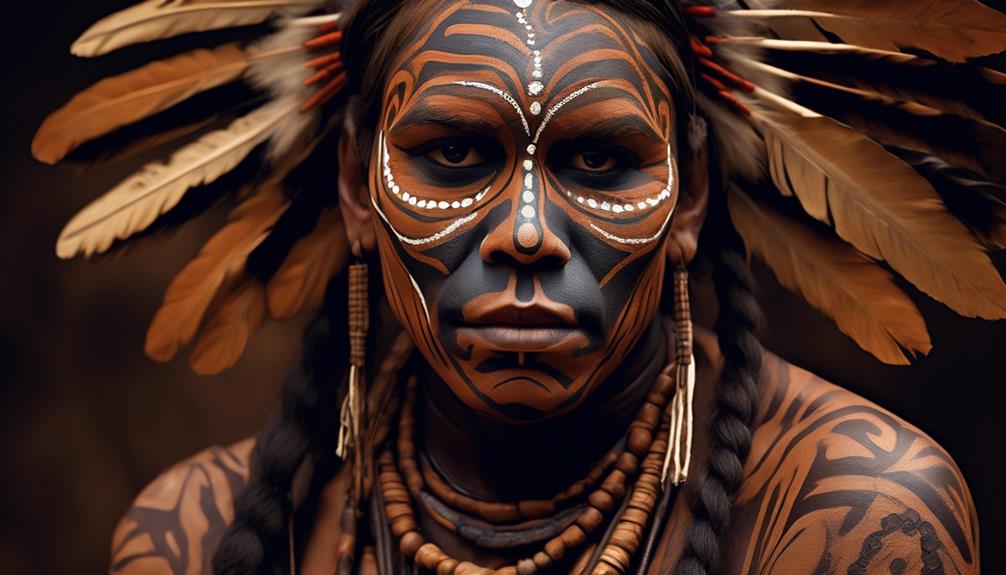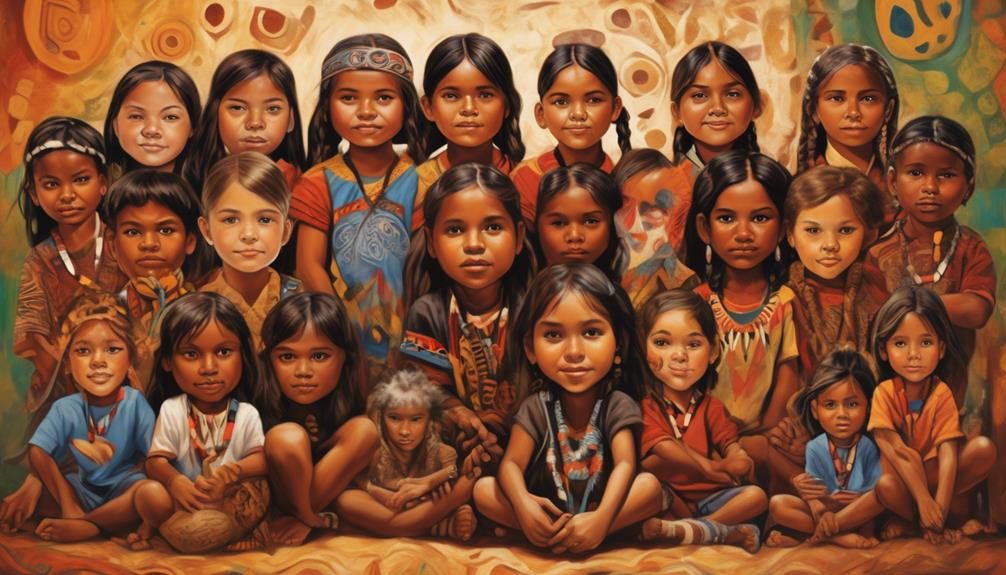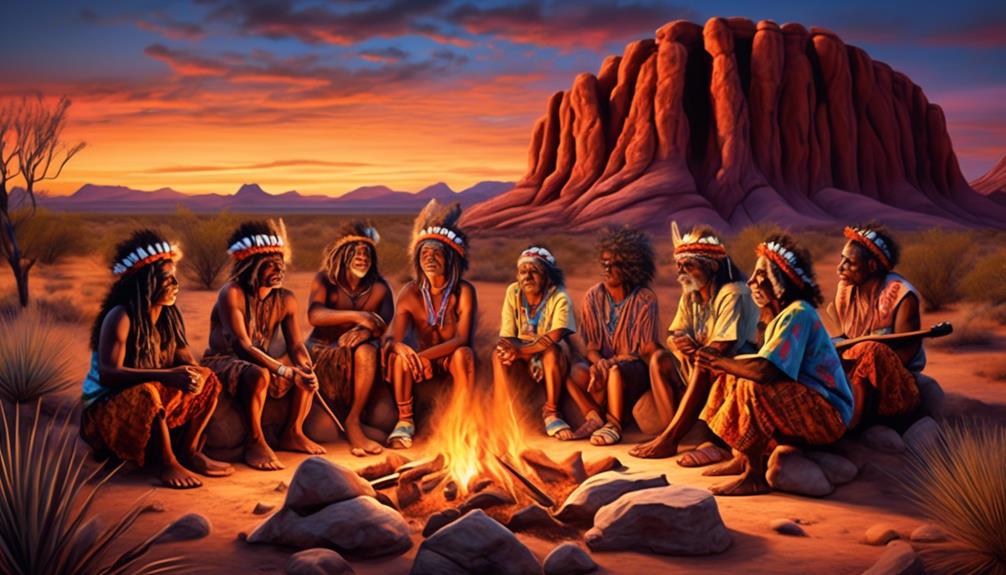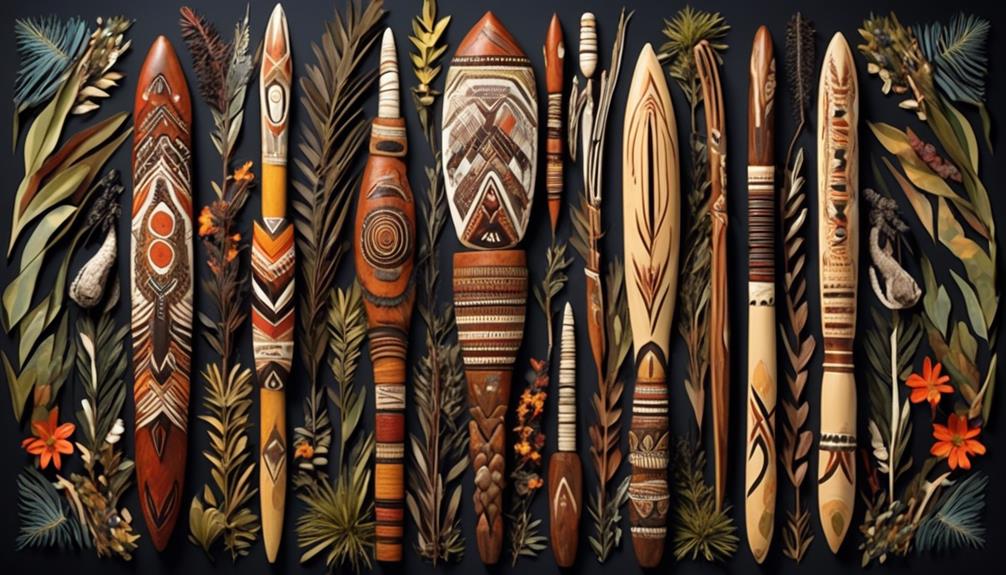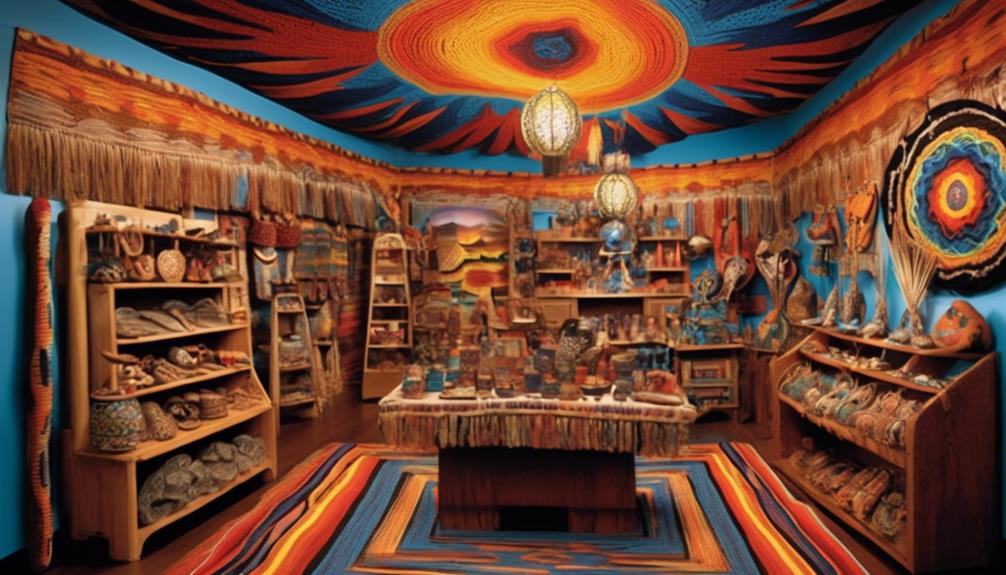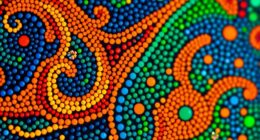Have you ever thought about the origins and significance of face paint in Aboriginal culture?
There is a common theory that suggests Aboriginal face paint was primarily used for decorative purposes, but the truth is much more intricate and profound.
As we explore the symbolism, traditional techniques, and contemporary significance of Aboriginal face paint, we'll uncover the deep-rooted cultural and spiritual significance that has been passed down through generations.
This exploration will shed light on the role of face paint in Aboriginal ceremonies and its revival in modern times, offering a fascinating glimpse into the rich traditions of Indigenous communities.
Key Takeaways
- Aboriginal face paint has deep cultural and spiritual meanings, and is tied to rituals, ceremonies, and significant life events.
- The symbols and patterns used in Aboriginal face paint convey specific meanings rooted in Aboriginal beliefs, with dots symbolizing connection to ancestors, land, and people, and lines representing journeys, animal tracks, and spirit paths.
- Traditional techniques and materials for creating Aboriginal face paint have been passed down through generations and are closely guarded within Aboriginal communities, ensuring authenticity and a symbolic link to the past.
- Aboriginal face paint plays a vital role in expressing cultural identity and spiritual connection, and fosters unity, belonging, and social bonds within the community.
Origins of Aboriginal Face Paint
The origins of Aboriginal face paint can be traced back to ancient cultural traditions and practices. Its historical evolution reveals deep-rooted cultural significance within Aboriginal communities. The use of natural pigments derived from plants, clay, and other materials wasn't merely for aesthetic purposes, but held profound cultural and spiritual meanings. The application of face paint was often tied to rituals, ceremonies, and significant life events, symbolizing connections to the land, ancestors, and the Dreamtime.
The historical evolution of Aboriginal face paint reflects the resilience and preservation of cultural identity despite the impact of colonization. It has been a way for Aboriginal people to assert their cultural presence and resist assimilation. Over time, the designs, patterns, and colors used in face paint have evolved, influenced by environmental factors, social changes, and intercultural exchanges.
Understanding the origins and historical evolution of Aboriginal face paint provides insights into the depth of cultural traditions and the resilience of Aboriginal communities. It serves as a powerful reminder of the enduring significance of traditional practices in contemporary Aboriginal society.
Symbolism in Aboriginal Face Paint
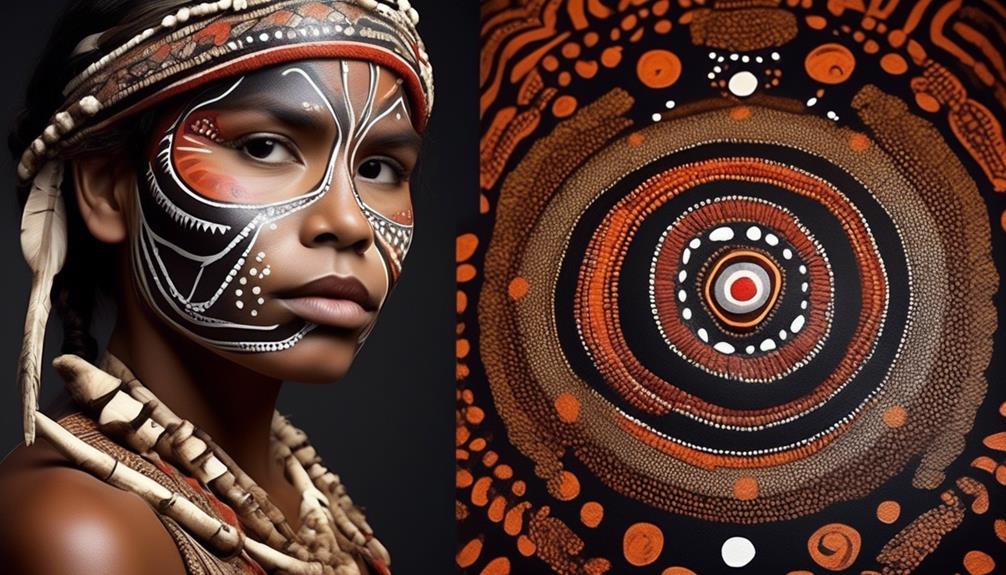
Symbolism in Aboriginal face paint is deeply intertwined with the historical evolution of cultural traditions and serves as a powerful representation of the enduring significance of traditional practices in contemporary Aboriginal society. The use of face paint in Aboriginal culture holds immense cultural significance, as it is often connected to spiritual representation and the preservation of ancestral knowledge. The symbols and patterns incorporated into the face paint are not merely decorative; rather, they convey specific meanings that are deeply rooted in Aboriginal beliefs and stories.
| Symbol | Meaning | Usage |
|---|---|---|
| Dots | Connection to ancestors, land, and people | Used in ceremonies and rituals |
| Lines | Journey, tracks of animals, and paths of spirits | Applied during storytelling and dance |
| Circles | Community, unity, and family | Worn at social gatherings and celebrations |
| Zigzag | Water, rivers, and dreaming tracks | Part of rainmaking ceremonies |
| Animal prints | Connection to specific animal spirits | Used in hunting and spiritual practices |
The cultural significance of these symbols in Aboriginal face paint cannot be overstated, as they serve as a visual language through which the rich tapestry of Aboriginal heritage is expressed. The spiritual representation embedded in these symbols fosters a profound connection to the natural world and the ancestral realm, reinforcing the enduring traditions of Aboriginal culture.
Traditional Techniques and Materials
Traditional Aboriginal face paint techniques and materials have been passed down through generations, embodying the cultural heritage and artistic expression of the Aboriginal people. Natural pigments play a central role in traditional Aboriginal face painting. These pigments are derived from various sources, including ochre, clay, charcoal, and other natural materials. The use of natural pigments not only reflects the Aboriginal people's deep connection to the land but also demonstrates their commitment to cultural preservation.
The process of creating face paint from natural pigments involves intricate traditional techniques, often involving grinding and mixing the pigments with natural binders such as animal fat or plant oils to achieve the desired consistency and color. These techniques are often closely guarded within Aboriginal communities, passed down from elders to younger generations as part of the cultural heritage.
The use of natural pigments and adherence to traditional techniques not only ensures the authenticity of Aboriginal face paint but also serves as a symbolic link to the past, reinforcing the continuity of cultural practices. Through the preservation of these traditional techniques and materials, the Aboriginal people continue to express their artistic heritage and maintain a profound connection to their ancestors and the land.
Role of Aboriginal Face Paint in Ceremonies
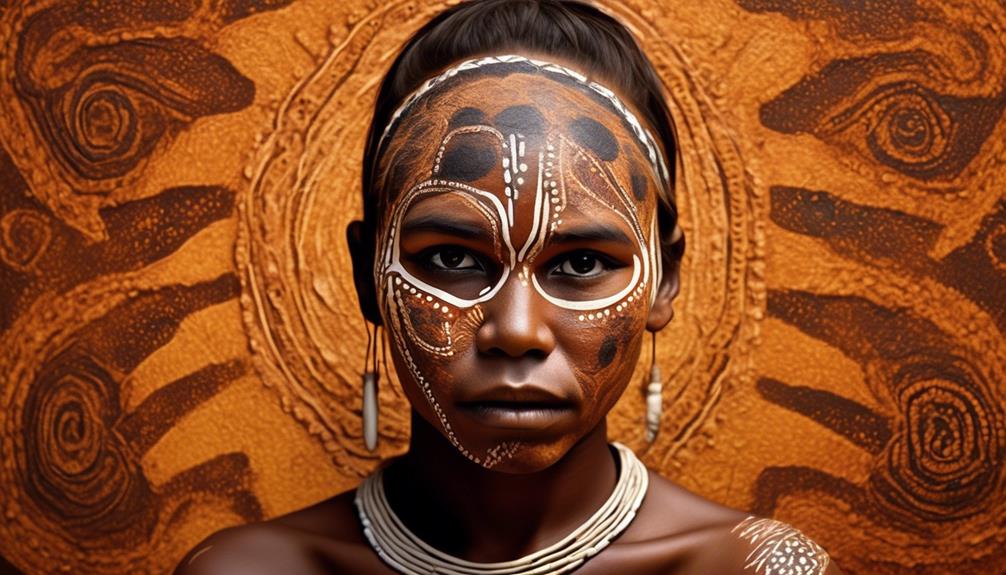
In Aboriginal ceremonies, face paint plays a vital role as a means of expressing cultural identity and spiritual connection. The cultural significance of face paint within Aboriginal communities can't be overstated. It's a practice deeply rooted in tradition and is integral to the preservation and expression of cultural heritage. The use of natural pigments and traditional techniques reflects the community's traditions and artistic expression, serving as a visual representation of their connection to the land and ancestral spirits.
The application of face paint is a sacred ritual, often accompanied by songs, dances, and storytelling. It serves as a medium for communicating with the spiritual world and honoring ancestors. The intricate designs and patterns aren't merely decorative; they convey specific meanings, such as belonging to a particular clan, marking significant life events, or symbolizing the natural elements essential to Aboriginal cosmology.
Furthermore, the act of adorning one's face with paint fosters a sense of unity and belonging within the community, reinforcing social bonds and shared cultural identity. The role of Aboriginal face paint in ceremonies transcends mere adornment; it serves as a profound expression of spirituality and cultural continuity.
Contemporary Significance and Revival
The resurgence of Aboriginal face paint in contemporary society reflects a renewed interest in preserving cultural traditions and embracing indigenous identity. This revival signifies a shift towards recognizing the importance of Aboriginal culture in the modern world and acknowledges the significance of traditional practices. The application of Aboriginal face paint today extends beyond ceremonial use and has gained traction in various cultural events and artistic expressions.
- Cultural Appreciation: The revival of Aboriginal face paint serves as a means for individuals to appreciate and honor the rich cultural heritage of Indigenous communities.
- Cultural Appropriation Debate: The contemporary use of Aboriginal face paint has sparked discussions about cultural appropriation, prompting a deeper understanding of the ethical considerations surrounding the adoption of indigenous practices.
- Modern Adaptations: Contemporary artists and designers are incorporating Aboriginal face paint motifs into fashion, visual arts, and performance, showcasing the adaptability of this tradition in modern contexts while maintaining respect for its cultural significance.
The contemporary significance of Aboriginal face paint lies in its ability to bridge the gap between tradition and modernity, fostering a deeper appreciation for Indigenous culture while navigating the complexities of cultural exchange.
Frequently Asked Questions
Are There Any Specific Rules or Taboos Regarding Who Can Wear Aboriginal Face Paint?
When discussing cultural appropriation and Indigenous representation, it's essential to consider any specific rules or taboos regarding who can wear Aboriginal face paint. This topic requires sensitivity and respect for the cultural significance of such practices.
Understanding and honoring the traditions and customs of Indigenous communities is crucial in addressing this question. It's important to approach this issue with a deep understanding of the potential impact on the community.
How Has the Use of Aboriginal Face Paint Evolved Over Time?
Evolution is a natural process that shapes our world. Throughout history, cultures have adapted and transformed, reflecting the ever-changing nature of society.
Significance of traditions shifts over time, leading to discussions about cultural appropriation and preservation efforts. These dialogues are vital in understanding the evolution of cultural practices and their impact on contemporary society.
Are There Different Styles or Designs of Aboriginal Face Paint for Different Tribes or Regions?
Yes, different tribes and regions have unique styles and designs of face paint. The significance of these designs varies based on cultural practices and traditions.
The diversity of these practices reflects the rich and varied cultural heritage of different Aboriginal communities. Understanding the distinct styles and designs of face paint allows for a deeper appreciation of the cultural diversity within Aboriginal communities and the significance of these artistic expressions.
What Are Some Common Misconceptions About Aboriginal Face Paint?
Common misconceptions about aboriginal face paint may arise from misunderstood traditions and the cultural appropriation debate. Our understanding of these practices can be clouded by historical inaccuracies and oversimplified narratives.
However, delving into the complexities of aboriginal face paint reveals the richness and diversity of indigenous cultures. By exploring the nuances of these traditions, we can gain a deeper appreciation for their significance and move beyond misconceptions.
Are There Any Efforts to Preserve or Protect the Traditional Knowledge and Practices Related to Aboriginal Face Paint?
Efforts to preserve and protect traditional knowledge and practices are crucial in respecting indigenous rights and preventing cultural appropriation.
Preserving these practices safeguards the cultural heritage of indigenous communities and ensures that their traditions are upheld with respect and dignity.
Conclusion
In conclusion, the revival of Aboriginal face paint holds great cultural significance for our community.
The use of traditional techniques and materials in contemporary settings brings a sense of connection to our ancestors and their traditions.
Through the symbolism and artistry of Aboriginal face paint, we honor our heritage and celebrate our cultural identity.
As we continue to embrace this ancient practice, we're reminded of the resilience and beauty of our Indigenous culture.
Talise is a talented writer and an expert in her field. Her unique perspective and insights enrich our content with depth and authenticity. With a wealth of knowledge and a strong connection to the subjects she writes about, Talise crafts engaging and informative articles that resonate with our readers. Her dedication to bringing Indigenous culture and wisdom to light is truly commendable.
